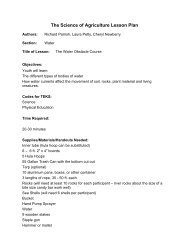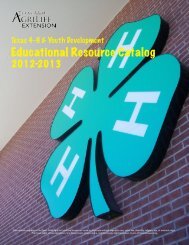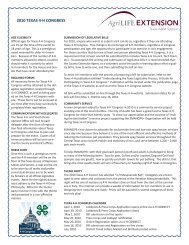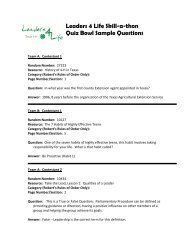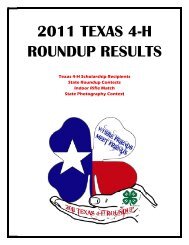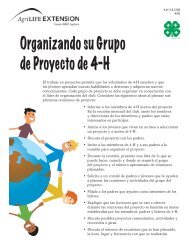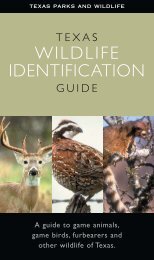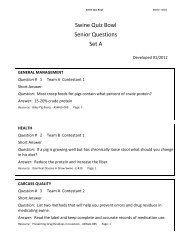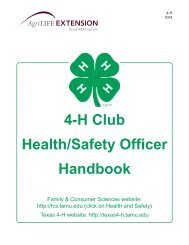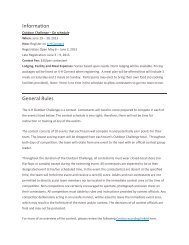How to Produce Broilers and Roasters for Show - Texas 4-H and ...
How to Produce Broilers and Roasters for Show - Texas 4-H and ...
How to Produce Broilers and Roasters for Show - Texas 4-H and ...
You also want an ePaper? Increase the reach of your titles
YUMPU automatically turns print PDFs into web optimized ePapers that Google loves.
L-5431<br />
5-05<br />
<strong>How</strong> <strong>to</strong> <strong>Produce</strong><br />
<strong>Broilers</strong> <strong>and</strong> <strong>Roasters</strong> <strong>for</strong> <strong>Show</strong><br />
Fred D. Thornberry<br />
Professor <strong>and</strong> Extension Poultry Specialist<br />
The <strong>Texas</strong> A&M University System<br />
A Successful Exhibi<strong>to</strong>r Must<br />
1. OBSERVE ALL SHOW RULES AND REGULA-<br />
TIONS governing the purchasing <strong>and</strong> showing of<br />
broilers <strong>and</strong> roasters. Many shows now allow the<br />
exhibition of both pullets <strong>and</strong> cockerals.<br />
2. Purchase Pullorum-Typhoid clean meat strain<br />
chicks.<br />
3. Use <strong>to</strong>p-quality feeds.<br />
4. Follow recommended management practices during<br />
the entire brooding <strong>and</strong> growing period.<br />
5. Keep careful records of all expenses <strong>and</strong> receipts.<br />
6. Cull birds closely <strong>and</strong> select the show entry<br />
properly.<br />
Broiler projects are popular with 4-H <strong>and</strong> FFA members<br />
<strong>and</strong> are an integral part of most youth lives<strong>to</strong>ck<br />
shows. Roaster projects (broilers 10 <strong>to</strong> 14 weeks of<br />
age) are also popular. Both projects are especially<br />
suitable <strong>for</strong> youngsters with limited space. Most<br />
shows limit the number of chicks ordered <strong>to</strong> 25 or 50<br />
per exhibi<strong>to</strong>r.<br />
When planning <strong>to</strong> start a project, contact the county<br />
Extension office, a 4-H leader or an agricultural science<br />
instruc<strong>to</strong>r. Birds not shown can be slaughtered<br />
<strong>for</strong> home use or sold locally <strong>to</strong> special markets.<br />
Housing<br />
Expensive housing <strong>and</strong> equipment are not necessary.<br />
<strong>How</strong>ever, a clean, dry structure that can be well ventilated,<br />
a brooder or heat lamps <strong>to</strong> warm the chicks,<br />
<strong>and</strong> feeding <strong>and</strong> watering equipment are needed.<br />
Provide at least 2 square feet of floor space per broil-<br />
er. Openings on three sides of the building provide<br />
plenty of fresh air <strong>for</strong> the birds. Plastic sheeting can<br />
be used <strong>to</strong> close sides during brooding <strong>and</strong> in cold<br />
weather. Make certain the concrete or dirt floor is at<br />
least 6 inches above ground level <strong>to</strong> prevent flooding.<br />
The roof overhang should be sufficient <strong>to</strong> effectively<br />
protect against blowing rain.<br />
Preparation <strong>and</strong> Brooding<br />
Clean <strong>and</strong> disinfect the poultry house, feeders <strong>and</strong><br />
waterers at least two weeks be<strong>for</strong>e the chicks arrive.<br />
Wash the house down with soap <strong>and</strong> water. Then<br />
spray a commercial disinfectant labeled <strong>for</strong> use in<br />
poultry houses.<br />
Be prepared <strong>for</strong> the chicks 2 days in advance. Put at<br />
least 4 inches of litter on the floor of the cleaned,<br />
disinfected house. Wood shavings, cane fiber, coarse<br />
A typical building used <strong>for</strong> growing broilers or roasters<br />
<strong>for</strong> a youth project.
If a gas or an electric hover-type brooder is used, it<br />
should operate at a temperature of approximately 92<br />
degrees <strong>to</strong> 95 degrees F. Gradually reduce the temperature<br />
5 degrees each week until the birds are 3 <strong>to</strong><br />
4 weeks old or until the house temperature reaches<br />
70 degrees F.<br />
When chicks are com<strong>for</strong>table, they will bed down in<br />
a semicircle around the perimeter of the heat zone.<br />
If cold, chicks will crowd near the heat source. If <strong>to</strong>o<br />
warm, they will move <strong>to</strong> the outer limits of the<br />
brooder guard.<br />
Chilling can stunt chicks. In cold weather the heat<br />
source should be turned on 48 hours be<strong>for</strong>e chicks<br />
arrive <strong>to</strong> adequately heat the litter.<br />
Rearing<br />
After birds reach 4 weeks of age, the ideal temperature<br />
range is 60 <strong>to</strong> 75 degrees F.<br />
When winter temperatures permit, the house should<br />
be partially opened <strong>to</strong> improve airflow <strong>and</strong> remove<br />
moisture. Supplemental heat may be needed when<br />
the outside temperture is low.<br />
In hot weather, fans or evaporative coolers are used<br />
<strong>to</strong> cool birds more than 4 weeks old.<br />
Stir the litter daily <strong>to</strong> prevent packing. Damp or caked<br />
litter will cause health problems <strong>and</strong> affect bird per<strong>for</strong>mance.<br />
dry sawdust, peanut hulls or rice hulls make good litter.<br />
Hay makes very poor litter. Keep all sticks,<br />
boards <strong>and</strong> sharp objects away from the broiler<br />
house.<br />
Construct a cardboard brooder guard (brooder circle)<br />
<strong>to</strong> keep chicks near heat, water <strong>and</strong> feed. The brooder<br />
guard should be 14 <strong>to</strong> 18 inches high <strong>and</strong> must be<br />
a minimum of 5 feet in diameter <strong>for</strong> 50 chicks. When<br />
chicks are 7 days old, remove the guard <strong>and</strong> allow<br />
them full freedom of the pen.<br />
Electric heat lamps (infrared bulbs) are good heat<br />
sources <strong>for</strong> brooding chicks. Two 125-watt bulbs per<br />
50 chicks are recommended. Make certain lamps are<br />
secured so they cannot fall <strong>to</strong> the litter <strong>and</strong> create a<br />
fire hazard. The lamps should hang so that the bot<strong>to</strong>ms<br />
are 18 <strong>to</strong> 24 inches from the litter. Lamps can<br />
be raised or lowered depending on temperature conditions.<br />
Place waterers a good distance from the<br />
lamps <strong>to</strong> prevent splashing water from cracking the<br />
hot bulbs.<br />
Lighting<br />
Provide all-night light <strong>for</strong> broilers <strong>and</strong> roasters.<br />
Twenty-four-hour lighting (natural <strong>and</strong> artificial)<br />
improves feathering <strong>and</strong> increases weight, especially<br />
during the summer months. Hang a 40-watt bulb at<br />
least 6 feet above birds after removing heat lamps.<br />
Feeding<br />
Optimum per<strong>for</strong>mance is dependent on proper nutrition.<br />
The feed dealer should be in<strong>for</strong>med of the type<br />
of feed required at least 2 weeks be<strong>for</strong>e chicks arrive<br />
so that fresh feed can be ordered. It is absolutely<br />
essential that birds receive a high-quality poultry<br />
Water, feed <strong>and</strong> a heat source are all essential in getting<br />
chicks off <strong>to</strong> a good start.<br />
2
feed containing at least 20 percent protein. Lower<br />
protein feeds will not do the job. Some exhibi<strong>to</strong>rs<br />
start chicks on a high-protein (26 <strong>to</strong> 30 percent)<br />
turkey or game bird starter <strong>to</strong> stimulate additional<br />
growth. Feed the higher protein feed <strong>for</strong> 2 weeks.<br />
Switch <strong>to</strong> a broiler feed <strong>for</strong> the remaining feeding<br />
period.<br />
Small amounts of broiler feed lightly moistened with<br />
cooking oil <strong>and</strong> fed several times during the day will<br />
stimulate older birds <strong>to</strong> eat more <strong>and</strong> increase<br />
growth. This supplemental feeding practice can be<br />
particularly helpful in hot weather with birds more<br />
than 4 weeks of age. Caution: Do not put out more<br />
moistened feed than the birds can eat in 10 <strong>to</strong> 15<br />
minutes. Do not moisten the feed until feeding time.<br />
Be certain all birds can eat at the same time.<br />
An adequate level of vitamins in the diet is required<br />
<strong>to</strong> prevent leg weakness. Adequate vitamin intake<br />
can be ensured <strong>and</strong> leg problems minimized by<br />
adding water soluble poultry vitamins <strong>to</strong> drinking<br />
water at the manufacturer’s recommended level <strong>for</strong><br />
the first 7 days. Do not add vitamins past this period.<br />
Continued high levels can create health problems.<br />
All birds should be able <strong>to</strong> eat at once. One pie or<br />
cookie pan <strong>for</strong> feed <strong>and</strong> one chick waterer per 25<br />
chicks are needed the first 7 days. For the first 4<br />
weeks, one tube-type feeder per 25 birds is required.<br />
After 4 weeks, one tube-type feeder is needed <strong>for</strong><br />
every 15 birds. Clean, fresh water must be available<br />
at all times. One 2-gallon waterer per 50 chicks is<br />
required <strong>for</strong> the first 4 weeks. One 2-gallon waterer<br />
per pen is required after birds are culled at the end<br />
of the fourth week. Waterers should be rinsed daily<br />
<strong>and</strong> scrubbed twice weekly.<br />
Feed must be kept be<strong>for</strong>e birds at all times if maximum<br />
growth is <strong>to</strong> be attained. Tube feeders are recommended<br />
because they hold an ample supply of<br />
feed, can be adjusted easily as birds grow <strong>and</strong> are<br />
less likely <strong>to</strong> cause bruises than horizontal trough<br />
feeders. Feeders <strong>and</strong> waterers should be kept adjusted<br />
so that the trough portion is level with the back<br />
height of the birds.<br />
<strong>Broilers</strong> <strong>and</strong> roasters respond <strong>to</strong> attention. Walk<br />
among birds <strong>and</strong> stir feed three <strong>to</strong> five times per day.<br />
This will provide exercise <strong>and</strong> increase feed consumption<br />
<strong>and</strong> growth.<br />
Feather Picking <strong>and</strong> Cannibalism<br />
Snub the <strong>to</strong>p beaks of birds if feather picking or cannibalism<br />
starts. Trim one-third of the upper beak<br />
with an electric beak snubber. Vicks® salve or an<br />
anti-peck compound applied <strong>to</strong> the bloody pecked<br />
H<strong>and</strong>le birds carefully. Keep feeders <strong>and</strong> waterers level<br />
with the back height of the birds.<br />
spots will usually s<strong>to</strong>p cannibalism if snubbing is not<br />
feasible.<br />
Bird Health<br />
Keep all other poultry away from broilers <strong>and</strong> roasters.<br />
Medication should not be given unless birds are<br />
sick or stressed.<br />
Chicks purchased from late August <strong>to</strong> early<br />
November should be vaccinated <strong>for</strong> fowl pox by 14<br />
days of age.<br />
Parasites are seldom a problem where birds are properly<br />
managed <strong>and</strong> sanitary conditions maintained.<br />
Culling<br />
Birds should be rigidly culled <strong>to</strong> optimize per<strong>for</strong>mance.<br />
Small, sick, stunted or de<strong>for</strong>med birds should<br />
be removed when detected. Reduce flock size at 4<br />
weeks of age by removing the smaller <strong>and</strong> poorer<br />
fleshed birds. Keep two or three birds <strong>for</strong> each one <strong>to</strong><br />
be shown. Fleshing, uni<strong>for</strong>mity <strong>and</strong> finish will be<br />
improved by the increase in floor <strong>and</strong> feeder space<br />
<strong>and</strong> the reduction in social pressure. Trim nails <strong>to</strong><br />
help prevent carcass damage. Leg b<strong>and</strong> the birds kept<br />
<strong>for</strong> easy identification when selecting the show pen.<br />
Selecting the Exhibition Entry<br />
At show time examine birds carefully <strong>for</strong> physical<br />
defects that would cause them <strong>to</strong> be sifted. These<br />
include:<br />
• Cuts <strong>and</strong> tears<br />
• Broken <strong>and</strong> disjonted bones<br />
• Skin or flesh bruises anywhere other than on the<br />
wing tip<br />
3
• Breast blisters<br />
• Insect bites<br />
• External parasites (lice, mites or fleas)<br />
• Extremely dirty birds<br />
The following fac<strong>to</strong>rs must be carefully considered<br />
when selecting the show entry.<br />
A. Con<strong>for</strong>mation (describes the skeletal system or<br />
shape of the bird)<br />
Length. The breastbone should be long, straight,<br />
free from defects such as dents or knobs <strong>and</strong><br />
carry well <strong>for</strong>ward <strong>and</strong> back between the legs.<br />
The breastbone should be parallel <strong>to</strong> the backbone.<br />
Width. The back should be long <strong>and</strong> wide with a<br />
broad spring of ribs.<br />
Depth. The body should be full <strong>and</strong> deep. Body<br />
depth must be consistent with breast width.<br />
Length, width <strong>and</strong> depth should be well balanced.<br />
B. Fleshing (the amount <strong>and</strong> distribution of muscle<br />
or flesh on the bird)<br />
The breast, thighs <strong>and</strong> drumsticks carry the bulk<br />
of the meat <strong>and</strong> should be examined closely.<br />
The breast meat is the most valued part of a bird<br />
<strong>and</strong> should be given maximum consideration. The<br />
breast muscle should be wide throughout the<br />
A bird of normal development (a) has a more rectangular<br />
shape than a bird of low vitality. A bird whose body is<br />
more triangular (b) is less desirable.<br />
length of the keel bone. The muscle should carry<br />
well up <strong>to</strong> the crest of the bone. A dimpled breast<br />
is desirable.<br />
The thighs <strong>and</strong> drumsticks should be heavily<br />
muscled.<br />
C. Uni<strong>for</strong>mity<br />
Each broiler should be as near a carbon copy of<br />
its pen mates as possible in size, shape, fleshing<br />
<strong>and</strong> finish. If one bird has a defect, it will affect<br />
the rating of the entire pen.<br />
Uni<strong>for</strong>mity is not a fac<strong>to</strong>r with roaster entries<br />
unless pens of two or three birds are shown.<br />
D.Finish (amount of fat in <strong>and</strong> immediately under<br />
the skin)<br />
Finish is usually adequate on well-fleshed birds.<br />
Without an adequate finish, a well-fleshed broiler<br />
will lose a great deal of eye appeal. The fat deposition<br />
between feather tracts on the side of the<br />
breast is the best indication of finish. Do not confuse<br />
finish <strong>and</strong> pigmentation (skin color).<br />
E. Skin Pigmentation<br />
Skin pigmentation results from the deposition of<br />
yellow or yellow-orange pigments in the outer<br />
skin layer. It is not an indication of finish. Only<br />
minor emphasis should be placed on pigmentation.<br />
H<strong>and</strong>ling <strong>and</strong> Transportation<br />
Record leg b<strong>and</strong>s of birds selected <strong>for</strong> show. Put<br />
selected birds back in the pen with the remaining<br />
birds until you transport them <strong>to</strong> the show.<br />
Properly reared birds usually are reasonably clean.<br />
Washing is not recommended.<br />
Large cardboard boxes are ideal carriers. Never place<br />
more than four broilers or two roasters in a box<br />
when transporting them <strong>to</strong> a show. Do not crowd.<br />
Put 4 inches of litter in the container so breasts will<br />
not bruise or become reddened. Be certain <strong>to</strong> cut<br />
adequate air holes in the sides. Avoid bruising birds<br />
while putting them in or taking them out of the container.<br />
Above all, do not drop the container.<br />
Important: Check birds carefully <strong>for</strong> bruises one<br />
final time be<strong>for</strong>e presenting them <strong>to</strong> the sifter.<br />
4
Precautions<br />
1. Feed quality feed.<br />
2. Cull closely <strong>and</strong> provide adequate floor <strong>and</strong> feeder space.<br />
3. Maintain a com<strong>for</strong>table temperature range.<br />
4. Never allow birds <strong>to</strong> be without feed <strong>and</strong> water.<br />
5. Do not exceed vitamin recommendations.<br />
6. Keep litter in good condition.<br />
7. Provide supplemental feed in the correct manner.<br />
8. Obtain prompt assistance if health problems occur.<br />
9. Ventilate properly.<br />
10. Review this publication weekly <strong>and</strong> closely follow suggestions.<br />
Family Safety<br />
Public health agency investigations have implicated improper h<strong>and</strong>ling of<br />
poultry with occasional outbreaks of disease in humans. Protect your family<br />
from bird-transmitted diseases by following these guidelines:<br />
1. Do not bring live poultry of any age in<strong>to</strong> the home.<br />
2. Always wash your h<strong>and</strong>s thoroughly with soap <strong>and</strong> water after contact<br />
with poultry.<br />
3. Do not allow <strong>to</strong>ddlers <strong>to</strong> h<strong>and</strong>le poultry.<br />
4. Avoid contact with poultry feces.<br />
5. Wash your h<strong>and</strong>s, counter <strong>to</strong>ps <strong>and</strong> utensils with hot, soapy water<br />
after h<strong>and</strong>ling raw poultry. (You may also wish <strong>to</strong> obtain Extension<br />
publication L-5088, “Enjoy Poultry Meat Safely,” from the county<br />
Extension office. It is also available on the Web at<br />
http://tcebooks<strong>to</strong>re.org)<br />
5
<strong>Produce</strong>d by Agricultural Communications, The <strong>Texas</strong> A&M University System<br />
Extension publications can be found on the Web at: http://tcebooks<strong>to</strong>re.org<br />
Visit <strong>Texas</strong> Cooperative Extension at: http://texasextension.tamu.edu<br />
Educational programs of <strong>Texas</strong> Cooperative Extension are open <strong>to</strong> all people without regard <strong>to</strong> race, color, sex, disability, religion, age or<br />
national origin.<br />
Issued in furtherance of Cooperative Extension Work in Agriculture <strong>and</strong> Home Economics, Acts of Congress of May 8, 1914, as amended,<br />
<strong>and</strong> June 30, 1914, in cooperation with the United States Department of Agriculture. Edward G. Smith, Interim Direc<strong>to</strong>r, <strong>Texas</strong> Cooperative<br />
Extension, The <strong>Texas</strong> A&M University System.<br />
5 M, Reprint




